Many birds and other vertebrates have innovative strategies for survival and the weather loach is certainly one of them.
I’ve mentioned before that the weather loach (pond loach, dojo loach) is a slender and eel-like freshwater fish native to East Asia that has become invasive in many of our waterways largely because aquarists release them into our streams and ponds. Though they’re a great food source for our fish-eating birds they’ve become an ecological nuisance. I didn’t even know they existed until I began photographing birds ten years ago but since then I’ve become aware of just how prevalent they’ve become in the valley waterways of northern Utah.
These fish are often called weather loaches because they’re extremely sensitive to slight changes in barometric pressure and they become hyperactive and even “stand on their tails” in aquariums when a weather front is approaching.
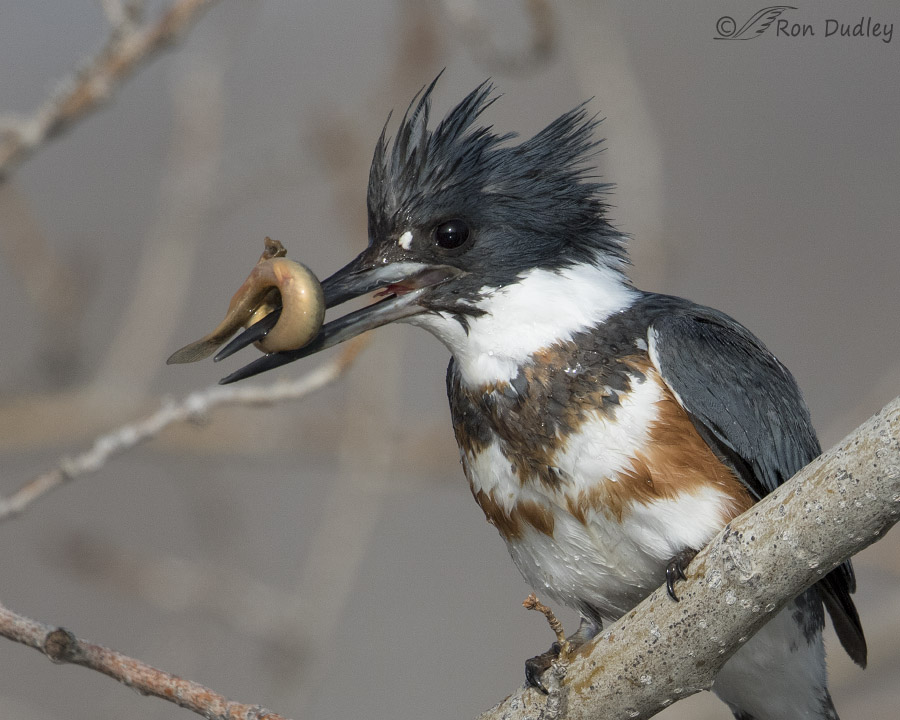
1/2500/ f/7.1, ISO 500, Canon 7D Mark II, Canon EF 500mm f/4L IS II USM + EF 1.4 III Extender, not baited, set up or called in
As regular readers know weather loaches have been the staple food of “my” male Belted Kingfisher this fall at an old oxbow wetland near the Jordan River. I’ve watched and photographed him (and this female) catching and eating dozens of fish and without exception every fish I’ve been able to see well enough to identify has been a weather loach.
To demonstrate just how pervasive this invasive fish has become here’s a few examples of other birds I’ve documented capturing and eating weather loaches over the years at places like Farmington Bay Waterfowl Management Area, Bear River Migratory Bird Refuge and near the Jordan River:
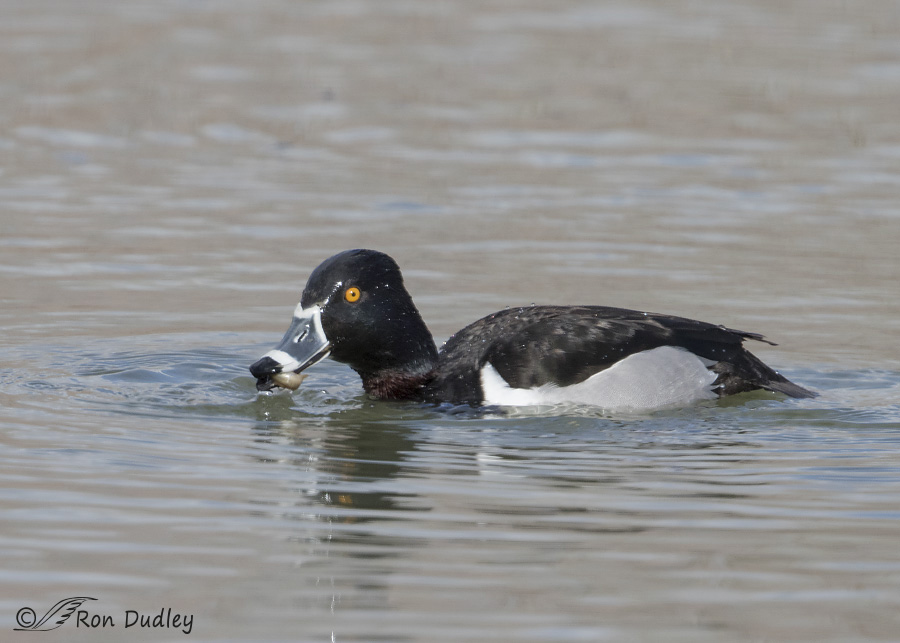 1/2000/ f/6.3, ISO 500, Canon 7D Mark II, Canon EF 500mm f/4L IS II USM + EF 1.4 III Extender, not baited, set up or called in
1/2000/ f/6.3, ISO 500, Canon 7D Mark II, Canon EF 500mm f/4L IS II USM + EF 1.4 III Extender, not baited, set up or called in
Ring-necked Duck.
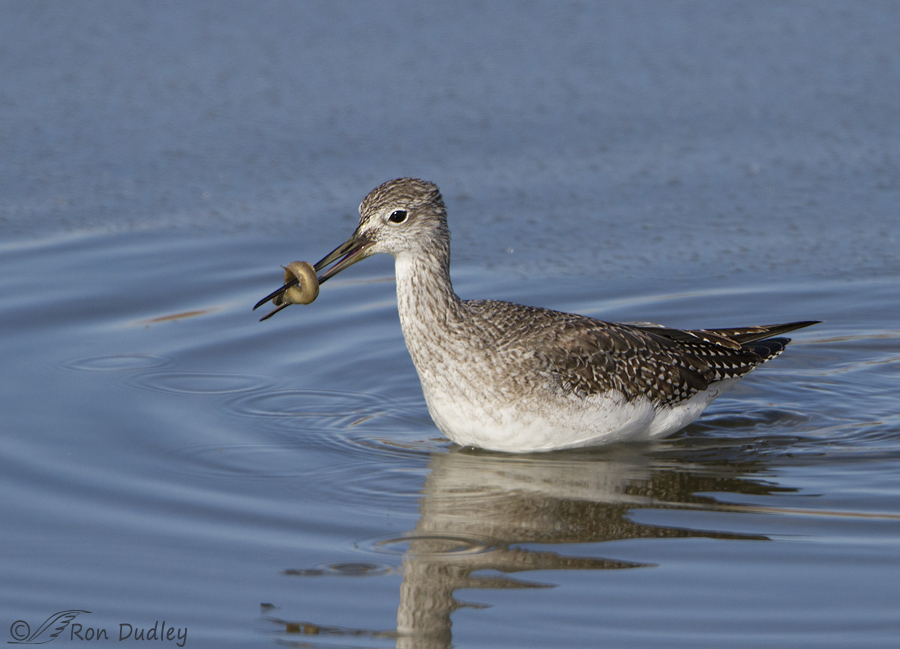
1/2000/ f/6.3, ISO 500, Canon 7D, Canon EF 500mm f/4L IS USM + EF 1.4 III Extender, not baited, set up or called in
Greater Yellowlegs.
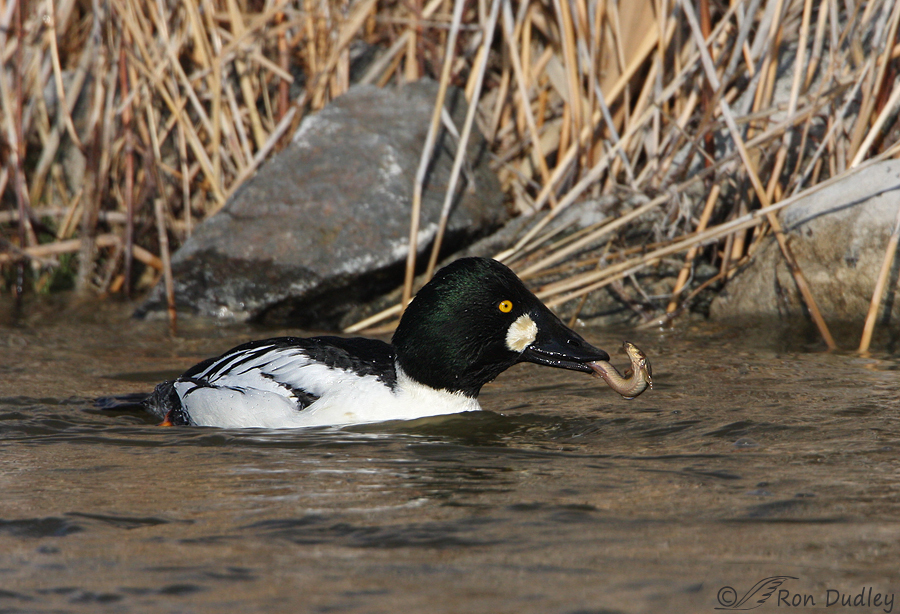
1/3200/ f/9, ISO 640, Canon 40D, Canon EF 500mm f/4L IS USM + EF 1.4 III Extender, not baited, set up or called in
Common Goldeneye.
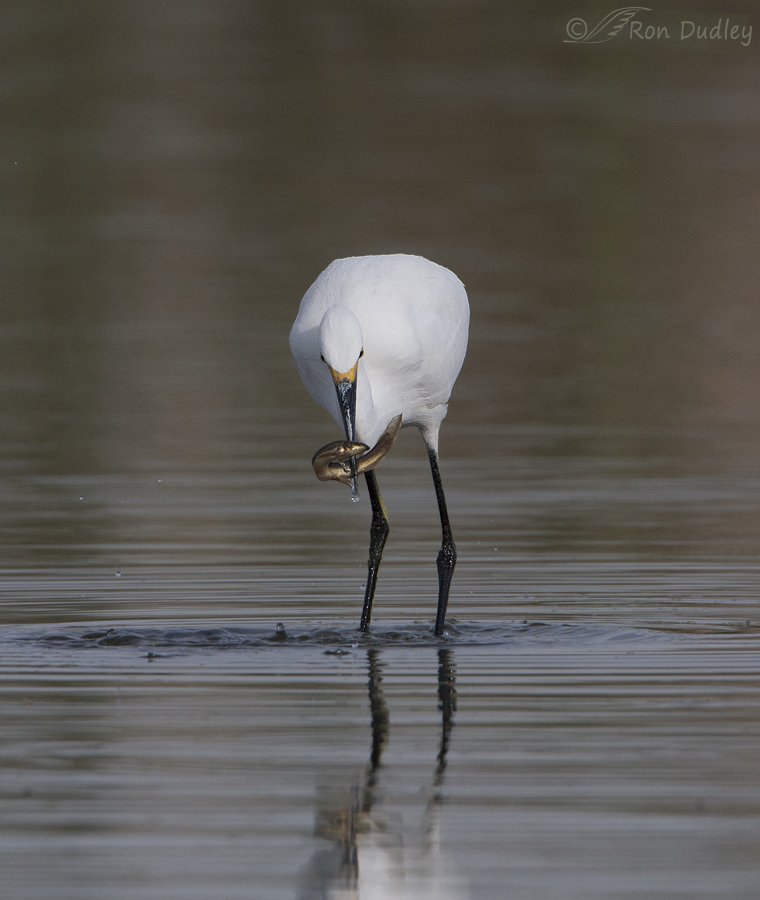
1/1000/ f/11, ISO 500, Canon 40D, Canon 40D, f/4L IS USM + EF 1.4 III Extender, not baited, set up or called in
Snowy Egret.
Roughly eight years ago I asked management personnel at Farmington Bay WMA if they knew what species the fish was but they had no idea so I sent some photos to my good friend and Director of The Great Salt Lake Nature Center at Farmington Bay Justina Parson’s-Bernstein. She forwarded them to a vertebrate specialist with the State of Utah and he keyed the fish out as weather loaches. I’ve been seeing them regularly ever since.
Ok, here’s the “extreme survival” part of the story.
Earlier this fall the very small oxbow wetland “pond” where I’d been photographing the kingfisher dried up completely. This time of year its only source of water is storm drains (I know that because I talked to Murray City Parks Superintendent Kim Sorenson about it) and we hadn’t had any rain for months. That small pond was bone dry for about a week before we had a storm which immediately filled it up again. Of course the kingfisher had stopped showing up and I figured it would be next year sometime before enough time would have passed for the fish to repopulate the pond and lure the kingfisher back.
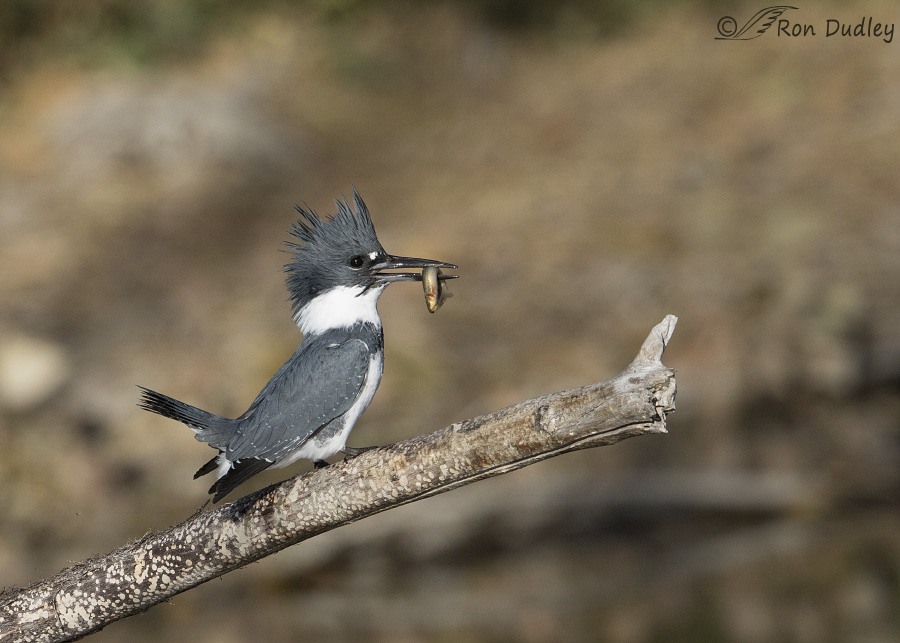
1/5000/ f/6.3, ISO 640, Canon 7D Mark II, Canon EF 500mm f/4L IS II USM + EF 1.4 III Extender, not baited, set up or called in
So I was blown away when two days after the pond filled again the kingfisher was back and catching loaches with almost every dive (I believe this photo was taken on that very day). Where had all those loaches come from? The only water to have entered the pond was from storm drains which wouldn’t have any fish and two days isn’t nearly enough time to repopulate the pond through natural reproduction.
Then I remembered something I’d read about weather loaches some years ago. In drying conditions they burrow down into the mud, secrete a mucus “cocoon” around their body to prevent drying, and simply wait until the water comes back. They “breathe” by gulping small amounts of air into their gut so oxygen can be absorbed into their intestinal blood. There are a few other types of fish that do the same thing.
So that explained the mystery.
What an incredibly effective and innovative survival strategy for weather loaches! That’s good news for my kingfishers (and for this bird photographer) but bad news for natural resource managers who might want to control invasive loaches by diverting water from ponds and streams.
Ron


Sorry I’m super-late to the party today. Loaches have evolved some pretty cool adaptations. The article about the effects of natural selection pressures on snail kite evolution was really interesting too.
WATCHING TRUMP…IN SALT LAKE CITY…YOUR BACK YARD…DESTROYING AS MANY NATIONAL MONUMENTS AS HE CAN…LYING THROUGH HIS YELLOW TEETH!!! SAD, SAD, SAD!!! To HELL WITH FIRTIRE GENERATIONS..
Patty best not to wind me up on this issue! I can go off like a whirling derbish and that’s never good. I use lots of adult language and my blood pressure goes through the roof. Yours does too! ((((HUGS))))
Hiss and spit. And rather a lot of expletives.
I’m with you EC!!
I am always amazed at the resilience of critters. Yet another area where I am pretty certain that the ‘inferior species’ leave us gasping in the dust.
And really wish that we would learn before introducing species to alien (to them) territory – and not revile those same species when they thrive.
EC, I understand that your land of Oz has more than its fair share of invasive species.
We do. Most of them introduced with good intentions. Rabbits and cane toads spring to mind immediately. There are others too.
EC I know there are a bunch of wannbe falconers in Oz who would just love to help with the rabbit over population. Alas, they’re not allowed!
Speaking of evolution and all, I’d suspect the overabundance of weather loaches will inspire a response in an increase in the number of critters who feed on them, both in terms of increased populations of predators and in the number of predators who will start eating them to deal with the issue of free food. After all, something like that happened when humans encountered artichokes and other more obnoxious plants/animals…LOL!
In most situations there are positive and negative elements. Now that said, they’re icky-looking critters.
Who knows, you may be right, Laura. I’ve always liked “icky” as a descriptor…
Oh I forgot to mention the weather loach’s survival mechanism. That’s pretty darn cool when you think about it. Aren’t there several species of desert frogs who have a similar survival strategy? Somewhere, way back in the belfry with the bats, there’s a memory of that. It’s all covered in cobwebs, though!
And yes, I’m a fan of icky, too
Yes, there are frogs (and even toads which is even more impressive) that do something similar.
And….aquaium owners who have weather loachers say they are among the most responsive to their “owners”…
Yup, some say they can even “pet” them.
That’s what I heard, too…
Wow!! Beautiful pictures!! And Thankyou for the info on loaches .. Dr. Dudley!!! I didn’t know what they were .. ( baby catfish ) and about yesterday ,, I have seen no rough legged hawks .. counted 22 redtails in one day
) and about yesterday ,, I have seen no rough legged hawks .. counted 22 redtails in one day
Thanks, Marina. At least you’re seeing lots of raptors!
Yes and even more kestral !!! Still looking for that roughie
I guess these critters can be added to the “ultimate survivors ” list ( cockroaches, coyotes, etc. )–I’d nominate spade foot toads , who burrow underground and survive very long periods of drought
as well……I’d love it if someone in this blog audience could describe the mechanism involved in the weather loach’s extreme response to barometric pressure change–might it help me understand
arthritic response in human beings to the same conditions ?
That’s a good question, Kris. I wondered the same thing.
Kris, years ago, my rheumatologist explained the pain response as a sudden drop in barometric pressure and a rise in a weather factor that escapes my memory now. I knew that just a couple of weeks ago, but I’ve evidently slept since then (and soundly). Stuff falls out. SIGH! And DARGH, too!
Just our luck that an invasive species would have such a good drought survival adaptation, huh?
Yup…
Here is more grist for the evolution mill…
https://www.eurekalert.org/pub_releases/2015-06/ru-esf061515.php
Wow, in a single generation!
Fantastic shots and very interesting info. Ron!
Charlotte
Thanks, Charlotte.
Very interesting story about how the weather loaches survive. We have three species of freshwater shrimp at Hueco Tanks, and they can go through a whole life cycle in two weeks, leaving their eggs to weather the dryness. Often, two weeks is as long as the water stays in the huecos (hollows in the rocks). Our toad species all burrow and wait for the water to return. The one thing I haven’t figured out is how the leeches do it (We’ve seen leeches in one particular ponding area on two widely separated occasions). For the record, the Kingfisher in the first photo is a female (you were talking about “your” male Kingfisher). I love learning about the way animals survive in very arid areas.
Thanks for pointing out that I wasn’t clear about which kingfisher I was referring to, Susan. I’ve edited what I said.
I wonder how they might compete with local fish? Perhaps they are a boom for the fish eating birds? I think the loaches are an ugly leach looking fish, I am glad something will eat them.
“I wonder how they might compete with local fish?”
I don’t know for sure, April, but since I see so few fish there other than loaches I doubt the news is good. At Farmington the carp seem to be more than holding their own against them but of course they’re invasive too.
Evolution, Evolution, isn’t grand!!
What a wonderful series Ron, this is pure joy and delight to me, or for that matter to anyone liking biology. What a sweet set of images, thank you for the story, and showing in graphic detail how a food source is utilized rather than its occurrence just being a hindrance.
One of your best!
Sorry first sentence should be isn’t it grand!
Should have read it over before pushing the send button.
Dick, as a huge fan of evolution (like me) you might want to check out a blog post published just this morning by my good friend “Wichersham’s Conscience”. It’ll make you smile along with me and Charles Darwin…
https://wickershamsconscience.wordpress.com/2017/12/04/why-charles-darwin-is-smiling/
Thanks for putting up WC article, Love it!! All I can say as a Biology Teacher, after reading about Darwin’s Voyage of the Beagle and later “The Beak of the Finch” plus countless other books, I have never strayed from believing evolution is going on in plain sight!
Thanks SO much for providing that link! What an entertaining blog (from the perspective of YES! Evolution IS a thing!!)! I have never understood the deniers when the proof is right in front of our collective noses! DARGH! What’s WRONG with some people?
Laura, WC writes a great blog – smart, informative, logical and eclectic posts.
Wow! Just wow!
Thanks, Linda.
One of the good news/bad news things for sure! Had a couple in my aquarium years ago and, no, they were NEVER released into the creek! Thx for the “lesson” once again!
Glad to hear you didn’t release them into your stream, Judy. Apparently they’re pretty fun to watch in an aquarium even though they often burrow down into the bottom where you can’t see them.